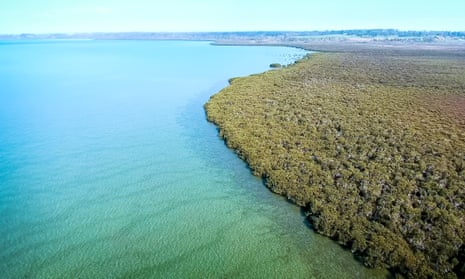Tanya Plibersek has blocked plans by the Victorian government to build a plant to assemble wind turbines for offshore windfarms because of “clearly unacceptable” impacts on internationally important wetlands.
Plans to build the terminal at the Port of Hastings – seen as critical for the state’s strategy to develop an offshore wind industry – included dredging up to 92 hectares (227 acres) of the Western Port Ramsar wetland and reclaiming 29 hectares of seabed.
The environment minister wrote in her rejection of the proposals that “large areas of the [wetland] will be destroyed or substantially modified as a result of direct impacts of the proposed action”.
The Victorian government set aside $27m in its last budget to progress the development, which it said would support “wind construction and delivery of up to 1GW per year” and serve multiple windfarm developments.
But Plibersek said the plan was likely to cause “irreversible damage to the habitat of waterbirds and migratory birds and marine invertebrates and fish” that were critical to the wetland.
The wetlands were one of Victoria’s three most important sites for wading birds, and regularly supported 20,000 or more waterbirds, the minister wrote, and the impacts of dredging and reclaiming large areas could not be mitigated or offset.
Plibersek’s department had advised the wetlands supported at least 1% of the global population of the eastern curlew and the curlew sandpiper – both critically endangered.
Eastern curlews migrate about 11,000km from Siberia and north-eastern China for the Australian summer.
Western Port was listed under the Ramsar convention for internationally important wetlands in 1982.
Sean Dooley, of BirdLife Australia, said: “Ramsar sites are not declared on a whim. This is a hugely important area for Victoria, for Australia and internationally. On principle, to destroy that amount of Ramsar wetland is not on.”
The federal opposition environment spokesperson, Senator Jonathon Duniam, said: “Victorian and federal Labor’s net-zero targets are a mess.
“They are clearly rushing this transition which will set Australia back and push power prices further up. Labor needs to be careful that they don’t wreck the environment in their renewables-only pursuit of net zero targets.”
Victoria has ambitions to deliver Australia’s first offshore windfarm developments and had described the project as “critical, nation-leading, enabling infrastructure” that would receive, assemble and install offshore windfarm foundations, towers and turbines.
after newsletter promotion
Quick GuideWhat are offshore wind energy plans in Australia?
Show
The Australian government has proposed six "high priority" offshore wind areas. Two - in Gippsland, in Victoria, and the Hunter, in NSW - have been declared. Another four are proposed for the Illawarra coast off Wollongong, north of Tasmania in Bass Strait, in southwest Victoria and in southern Western Australia following consultation periods.
Most zones are at least 10km from the coast. The government says creating an offshore wind industry will help the country replace ageing coal-fired power plants and reach net zero emissions by 2050.
There has been local opposition in NSW, and the South Australian government asked for the southwest Victorian zone not to cross its border.
The creation of an offshore wind zone does not guarantee development would go ahead. It is the first of five regulatory stages. Others include project-specific feasibility and commercial licences and an environmental assessment under national conservation laws. If successful, the first offshore wind farms could be built this decade.
There are different views on the role offshore wind could play. It can be a powerful source of renewable energy due to the placement and size of the turbines - at times, more than 300 metres in height - but the technology is significantly more expensive to build than onshore renewable energy.
The offshore wind industry has struggled overseas this year, with several projects cancelled and delayed, mainly due to rising construction costs.
The Victorian environment minister, Steve Dimopoulos, said the government was “undeterred” and would “digest the decision” before deciding what to do next.
“These processes exist for a reason because we have to balance biodiversity impacts.”
He said offshore wind was “critically important” for energy security in Victoria and Australia.
A Victorian government spokesperson said: “Victoria is proud to be developing Australia’s first offshore wind industry, which will be crucial for delivering national energy security and create thousands of jobs right here in Victoria. The Victorian Renewable Energy Terminal is key to achieving this.
“We are assessing the Commonwealth’s feedback to determine the next steps.”
Plibersek will have to make a decision later this year on a $1.3bn proposal for homes, restaurants and a marina at Toondah Harbour in Brisbane’s Moreton Bay that critics say will cause unacceptable damage to the Ramsar-listed wetlands there.
